

Power of Produce helps kids learn healthy eating habits
A weekly program run by USU Extension at the West Valley Farmers Market is geared to educating children about the importance of produce in their diets.
Editor’s note: In this special edition you’ll find articles related to all things food.
Eating plenty of fruits and vegetables is especially important for youth because it helps fuel their growing bodies and minds. Produce is packed with essential vitamins, minerals and fiber that support everything from strong bones and healthy skin to a sharp memory and a strong immune system. These nutrients are crucial during childhood and adolescence, a time of rapid growth and development.
That’s one reason why the West Valley Farmers Market, in conjunction with USU Extension, is running its Power of Produce Kids Program again this summer. Organizers know that in addition to supporting physical health, eating a variety of fruits and vegetables helps maintain a healthy weight and good digestion. It also builds healthy eating habits that can last a lifetime, and fresh produce is one of the best ways for young people to stay energized, focused and thriving.
“Our program uses a variety of fun exercises and activities to get kids involved with the farmers market,” said Laura Streeter from USU Extension. “The idea really is just to get them used to eating vegetables and introducing the kids to healthy foods, healthy lifestyle activities.”
Each Thursday during the farmers market, Power of Produce has a theme for the week. Upcoming in August and running through Oct. 9 are such events as Wonderful Worms, Movement Menu on Strength exercises, Plant Painting, a Scavenger Hunt, Stop Light Snacks, Scentsational Play, Movement Menu on Agility, Smarty Pants
By Tom Haraldsen | t.haraldsen@mycityjournals.com
Salad, Growing Frankengrass and Goofy Gratitude. Kids can earn wooden $1 tokens that can be spent with food vendors at the market—up to $2 a week.
“Last year, I made jars with worms in them, and the kids love those, so we’re going to bring those back again on Aug. 7,” Streeter said. “Our emphasis is just all about growing food, or tasting food, or moving their body, anything related to healthy lifestyles.”
She said the scavenger hunt on Aug. 28 will have kids look for a list of things in the market, getting them to interact with vendors and ask questions. And the Smarty Pants salad on Sept. 25 will focus on “the six parts of a plant that they can eat, like seeds. So last year, we brought some corn, the root, we brought some carrots, the stock, we brought some celery. We identified all these different parts that we can eat. And so I got the idea to put all six parts into a salad, and it incorporates everything all together. It’s a lot of fun.”
So far, this year’s program is going well. On opening night, 52 youth participated. Streeter said that translated into $104 in the hands of young people to spend at the market that night, so sometime during the run of the farmers market through the season that ends Oct. 9.
Because Utah State University is the land grant university for the state, every county has a USU Extension Office. In Salt Lake County, it’s on the corner of 2100 South and State Street, on the first floor of the south government building.
“Most people know about the extension because they’re familiar with programs like master gardener or the 4H program, which are all run by extension,” Streeter said. “My program is called Create Better Health, and we teach nutrition and healthy lifestyle habits. Extension is just a way for the university education to just reach out to the community to give back.”
Power of Produce runs each Thursday from 5 to 7 p.m. in West Valley City’s Centennial Park. l
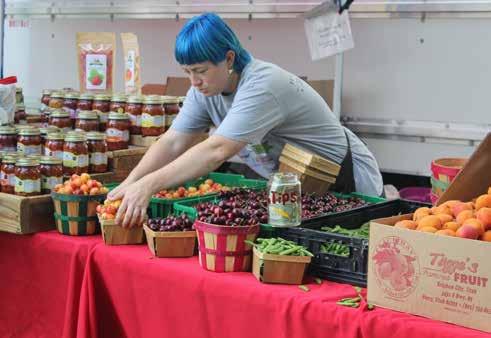
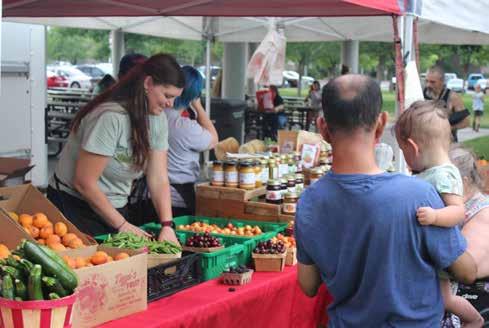
Vendors show their farm to fork products at the West Valley Farmers Market each Thursday night. (Tom Haraldsen/City Journals)



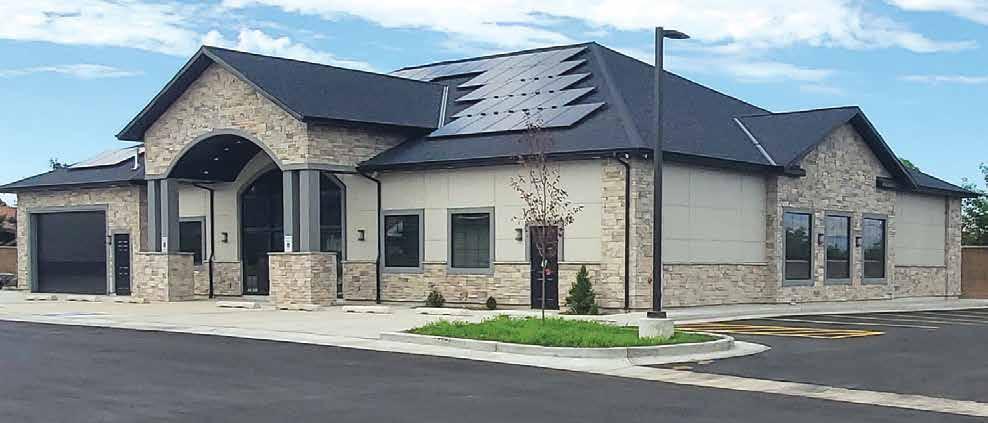




Reclaiming Life: Innovative Approaches to Managing Chronic Pain
For many, chronic pain is a relentless companion, impacting every facet of daily life. But hope is on the horizon. Breakthroughs in pain management being used at CommonSpirit hospitals are offering new avenues for relief, moving beyond traditional methods to provide more targeted and effective solutions.
Chronic lower back pain is one of the most common challenges. One of the most promising advancements for managing chronic low back pain, particularly for individuals suffering from vertebrogenic pain, is radiofrequency ablation (sometimes referred to as Intracept). This minimally invasive treatment is designed to provide long-lasting relief and improve overall quality of life by addressing the source of the pain, rather than simply masking the symptoms. In this procedure, a small probe is inserted through a tiny incision and guided to the basivertebral nerve and then radiofrequency ablation is used to disrupt the nerve’s ability to transmit pain signals.
“Radiofrequency ablation represents a significant shift in how we approach chronic lower back pain,” explains Dr. Snigdha Ancha, a leading pain management specialist. “By directly targeting the nerve responsible for transmitting pain, we can provide lasting relief for patients who haven’t found success with other treatments.”
But what makes radiofrequency ablation
so effective? Traditional pain management often relies on medications, physical therapy, or injections, which can provide temporary relief but don’t always address the underlying cause. Intracept, on the other hand, offers a more permanent solution by disrupting the pain pathway. Studies have shown significant reductions in pain scores and improved function in patients who have undergone the procedure.
Beyond radiofrequency ablation, other innovative techniques are gaining traction. Neuromodulation therapies, such as spinal cord stimulation (SCS), are becoming increasingly sophisticated. These devices deliver mild electrical impulses to the spinal cord, interrupting pain signals before they reach the brain. Newer SCS systems are designed to be more comfortable and customizable, allowing for personalized pain relief.



“We’re seeing remarkable results with neuromodulation,” says Dr. Jeffrey Pence, a pioneer in pain management technology. “The ability to fine-tune the stimulation to match each patient’s unique pain pattern is a game-changer. It’s not just about reducing pain; it’s about restoring quality of life.”
In addition to these advanced procedures, a holistic approach to pain management is crucial. This includes:
• Physical Therapy: Strengthening muscles, improving flexibility, and restoring function
• Cognitive Behavioral Therapy (CBT): Helping patients manage pain through coping strategies and behavioral changes
• Mindfulness and Meditation: Reducing stress and improving pain tolerance
It’s important to remember that pain management is not a one-size-fits-all solution. The best approach is tailored to each individual’s specific needs and circumstances. A comprehensive evaluation by a qualified pain management specialist is essential to determine the most appropriate treatment plan.
If you’re living with chronic pain, don’t lose hope. The advancements in pain management are offering new possibilities for relief and a chance to reclaim your life. Talk to your doctor about the latest techniques and find a path that works for you.

Learn more about the services, care providers and missiondriven work of the Holy Cross hospitals and CommonSpirit Health at www.holycrossutah.org.

At CommonSpirit Health, we make the healing presence of God known in our world by improving the health of the people we serve, especially those who are vulnerable, while we advance social justice for all.
minutes count, count on our emergency care. Get to know us before you need us.
When you need emergency care fast, the closest emergency room is a smart thing to know. You never know the level of care you’ll need when an emergency happens and choosing the right ER can make all the difference. And a hospital ER comes with the confidence of additional services right on-site.
Congratulations to CommonSpirit Holy Cross Hospital – West Valley for receiving the Leapfrog Hospital Safety Grade-A Accreditation for the second consecutive time. Leapfrog Hospital Safety Grades are determined based on a rigorous assessment of various safety measures.
Find emergency care close to you at mountain.commonspirit.org
1-303-673-8166 (TTY: 711).
The Food Truck League helps connect food trucks to local events
Company helps coordinate about 150 food trucks in the state.
By Darrell Kirby d.kirby@mycityjournals.com
The food trucks you see during summer events in West Valley City at places like Fairbourne Station Plaza and Centennial Park don’t just randomly show up.
They are set up there through the coordinated efforts of a company that pairs food trucks with event organizers.
The Food Truck League is a private venture that has been helping cities and businesses offer a variety of cuisine at their public and corporate shindigs since it started in 2015 “with the concept to make food trucks more accessible,” said the league’s operations manager Eliot Steimle.
The Food Truck League generates revenue by scheduling the trucks for various events and the operators of those trucks pay the league for hooking them up with the functions that want them there. Events include city-sponsored activities like West Valley City’s annual WestFest in June or businesses that hold employee gatherings that might require catering that the truck owners can provide. Wedding receptions are another destination for mobile kitchens.
Steimle said the league keeps a database of information on the food trucks it directly works with, which totals about 150 of the 250 or so overall food trucks they have registered. “We track the metrics, including how fast they can go, how much they can sell, how popular (they are), whether they show up on time, all of that kind of stuff,” Steimle said.
The majority of the trucks operate along the Wasatch Front, but the farther reaches of the state are also seeing more meals on wheels. “St. George is actually improving quite a bit as a food truck scene. There’s a lot
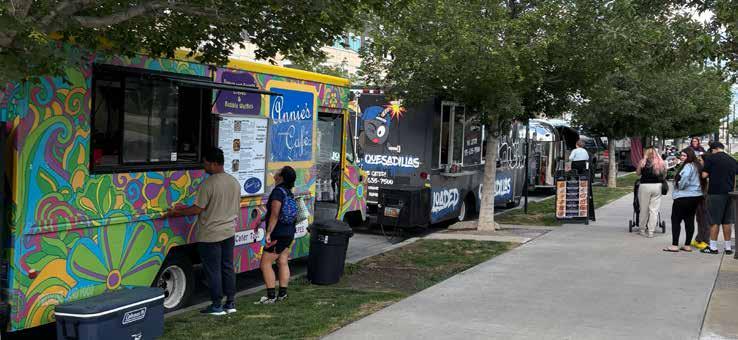
more festivals and a lot more food truck use than there used to be,” Steimle said.
The truck operators are usually based in or near where they do business, rather than the trucks traveling long distances to get to an event. Steimle said that the truck owners often weigh the cost of running their operations and getting to the events against the amount of money they hope to make when deciding whether an event is worth attending.
The type of cuisine cooked up in the trucks is more than just tacos and other Mexican fare often seen around town. It can range from American favorites like burgers and fries to waffles, Chinese food and a fusion of international flavors. Sometimes the food truck operators dish up creations derived from family recipes. Other offerings are sweet treats such as ice cream and churros.
That mix of trucks is important in that
too many serving the same or similar type of food can dilute the amount of business each truck can draw. A variety of edible delights is more likely to benefit each of the operators.
“It’s all different kinds so everyone has a different option,” Steimle said.
“The league is very helpful with booking events,” said Carly Shepherd of Springvillebased Waffle Love, which runs a fleet of food trucks and fixed locations in Utah, Arizona, California, Idaho and Texas. “We focus more heavily on private events, but public events are often super fun and are the bread and butter of any food truck.”
For San Diablo Artisan Churros, the truck lineup helps determine what locations are best for the company’s trucks and its sugary treats. “If there’s a lot of sweet trucks there, we try not to go because the competition takes away from profits,” said Krystal,
who preferred not to give her last name.
During the summer, Fairbourne Station Plaza is a regular spot for food trucks. Several of them line the street along the grassy area of the plaza just west of city hall and West Valley Central bus and TRAX station on Wednesdays from June through August. WestFest in June is another hotspot for food trucks.
Besides Utah where the league is based in South Salt Lake, it also operates in Arizona, Denver, Dallas and even New Zealand. Steimle said its goal is to take one more thing off the plate of both the organizations planning an event and especially the food truck operators who are trying to find places to feed the crowds. “It’s outsourcing their front desk a little bit, so they can focus on sourcing food and prepping and everything like that.” l
WEST VALLEY TEAM
The West Valley Journal is a monthly publication distributed directly to residents via the USPS as well as locations throughout West Valley City.
For information about distribution please email hello@thecityjournals.com or call our offices. Rack locations are also available on our website. The views and opinions expressed in display advertisements do not necessarily reflect or represent the views and opinions held by Loyal Perch Media or the City Journals. This publication may not be reproduced in whole or in part without the express written consent of the owner. © 2019 Loyal Perch Media, Inc.
Bryan Scott | bryan.s@thecityjournals.com
EDITOR
Travis Barton | travis.b@thecityjournals.com
ADVERTISING EXECUTIVES
Mieka Sawatzki | mieka.s@thecityjournals.com
Lindsay Andreasen | lindsay.a@thecityjournals.com
Jason Corbridge | jason.c@thecityjournals.com
Ryan Casper | ryan.c@thecityjournals.com
Marc Davis | marc.d@thecityjournals.com
Lydia Rice | lydia.r@thecityjournals.com 385-557-1022 Rack

UT 84070 PHONE: 801-254-5974
Food trucks line Lehman Avenue at Fairbourne Station in West Valley City in July. (Darrell Kirby/City Journals)


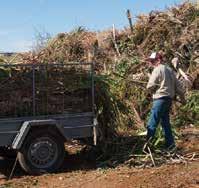
From $300 dreams to $1,000 realities—barbecue ain’t for the faint of heartburn
Rainy days can be a food truck’s biggest villain.
By Shaun Delliskave s.delliskave@mycityjournals.com
WhenKenneth Hunt rolled into Utah in the summer of 2019, he brought with him a weathered smoker, years of culinary experience and an unwavering Texas pride. Now, six years later, he’s the owner and sole operator of Hunt’s Texas BBQ, a mobile barbecue operation serving slow-cooked brisket and pulled pork to hungry customers across the Salt Lake Valley. But behind the smell of mesquite smoke and the sizzle of meat is a oneman production fueled by grit, consistency and a love for the craft.
“My wife and two kids moved down here from Houston in June of 2019,” Hunt recalled. “After living in the Houston area for 40-plus years, I’ve had my fair share of hurricanes and storms and whatnot…we were just at the point to where we were tired of redoing a house and dealing with floods and everything that came along bad—the chemical plants and everything like that.”
Utah, with its mountain views and considerably less humidity, offered a fresh start.
“I’ve always enjoyed barbecuing for friends and family and coworkers and stuff like that, so I figured I’d take a shot. We bought this trailer, added some pits, and that was 6 years ago. Been going strong since then,” he said.
But “going strong” doesn’t mean it’s easy. Hunt runs the truck solo, managing the entire operation from purchasing to prep to service. His wife, a schoolteacher, is busy during the academic year, leaving Hunt to wear every hat in the business.
“I pretty much do all my shopping and scheduling and whatnot,” he said. “So it gets a little hectic and crazy trying to juggle every hat to wear and still put out some great Texas barbecue.”
The day often begins before sunrise. The raspy voiced entrepreneur still maintains his friendly Texas drawl.
“I start cooking about six in the morning. And of course, these briskets—shoot—they go 10 to 12 hours at least, so nothing’s really served day-of. I’m smoking briskets constantly and pork butts. But with barbecue, there is no exact time. When they’re done, they let you know they’re done.”
That intuition—listening to the meat— comes from experience, not a recipe book. Once cooked, meats are wrapped and refrigerated until serving.
Unlike a brick-and-mortar restaurant, a food truck requires strategy: site scouting, setup and building a customer base from scratch. Hunt wasn’t sure if Utah was going to be a permanent home, so the trailer offered flexibility.
“With the price of real estate for a storefront, you gotta put a big investment into that and really, really, really want to stay here and put down roots. With that being said, it’s a lot
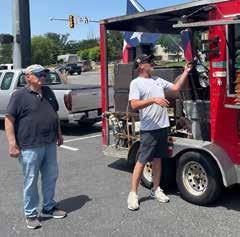
easier to chase the money, per se, with the food truck,” he said.
His livelihood was temporarily derailed as vandals hit his trailer one night. It took several days to get it in operating order.
And chasing the money means learning the terrain. Not every event is a winner.
“I remember my first year or so—if I could go out anywhere and make $300, I thought I was doing something really good,” Hunt said. “Now, six years later, those times have changed drastically.”
He’s learned which locations and partnerships are profitable, and which aren’t. For example, events with the local Food Truck League can be a double-edged sword.
“They’re great for starting out and stuff like that, but they do charge us food trucks 10%,” Hunt explained. “So always having to pay somebody money to do your own stuff is not really the best choice. You go out with 10 different trucks and some days it’s hard to make $1,000—you might only do $300 or $400. And for me, that’s not really sustainable.”
There’s also the logistical gamble of having too much food left over—a cardinal sin in Hunt’s book.
If he does bring anything back, it usually doesn’t excite his family. “After six years, my family really doesn’t care to dine on barbecue for dinner any longer.”
When the weather cooperates, business is better. “The rain is the only thing that'll stop me from serving. Nobody really wants to come out in the rain,” he said. “The snow—there’s no real problem here in Utah with the snow. People are used to it.”
Running the truck isn’t just about cooking—it’s also about customer service. And sometimes, that requires quick triage.
“There’s some people that want to be catered to when they come to you,” Hunt said. “And if there’s 20 people in line, you don’t always have that extra four minutes to sit and chat. Some people might get upset that I have to rush you through the line, but if it’s snowing outside, nobody really wants to wait 40 minutes to get their plate.”
Still, he makes time when he can. “If you
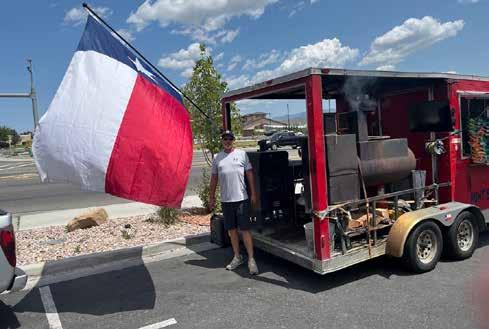
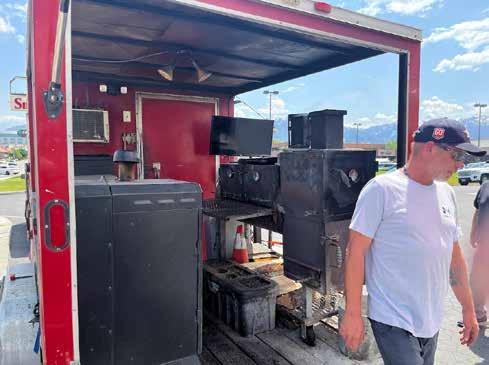
still want to chat when I’m done, more than happy to come outside the trailer and talk to you.”
Some days, he runs the truck five or six days a week. Other weeks, only twice. That’s the balance he tries to strike between work and life.
“My wife is a teacher and she’s off for summer, so there are times that I want to spend a couple days with her. We’ll take a vacation. I might cancel some events just so I can spend more time. Because it’s not always just about work.”
Even after six years, the flame hasn’t gone out.
“I still enjoy doing it,” he said. “I don’t know what else I’d do right now. After six
years of doing this—I still love it.”
You can find Hunt’s Texas BBQ trailer next location on Facebook or Instagram.l

Kenneth Hunt stands between his barbecue smokers and equally l arge Texas flag. (Shaun Delliskave/ City Journals)
Kenneth Hunt checks on his smokers before serving some fresh brisket. (Shaun Delliskave/City Journals)
Kenneth Hunt goes over the menu with a customer. (Shaun Delliskave/City Journals)
AUGUST CALENDAR OF EVENTS
1 Parker McCollum, 7:30 p.m., Maverik Center, 3200 Decker Lake Drive
1 & 2 Hozier, 7:30 p.m., Utah First Credit Union Amphitheatre, 5150 Upper Ridge Road
2 Northeast Granger Day of Service, 8 a.m., location TBA
5 - 8 Early Voting, West Valley City Hall, 3600 S. Constitution Blvd.
6 Bugs & Blooms with Modern Gardener, 6-8 p.m., UCCC, 1355 W. 3100 S.
7 Cops & Cleats Youth Basketball Camp, 8:30-11:30 a.m., WVC Family Fitness Center, 5415 W. 3100 South
7 WVC Farmer’s Market, 5-9 p.m., Centennial Park, 5405 W. 3100 South
7 Movie in the Park “Ferris Bueller’s Day Off”, starts at sundown, Centennial Park, 5405 W. 3100 South
8 Russ in the Wild Tour, 7 p.m., Utah First Credit Union Amphitheatre, 5150 Upper Ridge Road
9 Central Granger Day of Service, 8 a.m., location TBA
9 Old Dominion, 7 p.m., Maverik Center, 3200 Decker Lake Drive
10 RUFUS DU SOL, 7:30 p.m., WVC Farmer’s Market, 5-9 p.m., Centennial Park, 5405 W. 3100 South
11 Shinedown, 7 p.m., Maverik Center, 3200 Decker Lake Drive
12 PRIMARY ELECTION, 7 a.m.-8 p.m., West Valley City Hall, 3600 S. Constitution Blvd.
14 WVC Farmer’s Market, 5-9 p.m., Centennial Park, 5405 W. 3100 South
14 Nine Inch Nails, 7:30 p.m., Maverik Center, 3200 Decker Lake Drive
14 Cyndi Lauper, 7:30 p.m., Utah First Credit Union Amphitheatre, 5150 Upper Ridge Road
15 & 16 Chris Stapleton, 7:30 p.m., Utah First Credit Union Amphitheatre, 5150 Upper Ridge Road
18 Chill with the Chief, 6 p.m., Wheatland Park, 4266 S. 3680 West
20 Pantera, 7 p.m., Utah First Credit Union Amphitheatre, 5150 Upper Ridge Road
21 Counting Crows, 7:30 p.m., Utah First Credit Union Amphitheatre, 5150 Upper Ridge Road
21 WVC Farmer’s Market, 5-9 p.m., Centennial Park, 5405 W. 3100 South
22 Partners in the Park (With Healthy Start West Valley), 4-7 p.m., Centennial Park, 5405 W. 3100 South.
22 Alabama Shakes, 8 p.m., Utah First Credit Union Amphitheatre, 5150 Upper Ridge Road
23 West Granger Day of Service, 8 a.m., location TBA
23 $uicide Boy$, 6:30 p.m., Utah First Credit Union Amphitheatre, 5150 Upper Ridge Road
23 Upchurch and The Dixielanders, 8 p.m., Maverik Center, 3200 Decker Lake Drive
26 GOO GOO DOLLS, 7:30 p.m., Utah First Credit Union Amphitheatre, 5150 Upper Ridge Road
27 Toto + Men at Work + Christopher Cross, 6:45 p.m., Utah First Credit Union Amphitheatre, 5150 Upper Ridge Road
28 Little Big Town, 7 p.m., Utah First Credit Union Amphitheatre, 5150 Upper Ridge Road
29 Big Time Rush, 7 p.m., Utah First Credit Union Amphitheatre, 5150 Upper Ridge Road
29 Luis R. Conriquez, 7 p.m., Maverik Center, 3200 Decker Lake Drive Sept. 1 Labor Day/City Offices closed
Hospital chapel offers place for spiritual healing, contemplation
Holy Cross Hospital West Valley opens a small chapel for patients and visitors.
By Darrell Kirby d.kirby@mycityjournals.com
Holy Cross Hospital in West Valley City is a place for the treatment and healing of physical ailments.
Now it has a space for spiritual well-being.
The hospital, owned by Catholic nonprofit healthcare company CommonSpirit Health, recently opened a small chapel as a space for “solace, meditation and prayer for patients and their families of all faiths,” according to the Chicago-based Catholic nonprofit healthcare company, which has four other hospitals in Utah.
The chapel was commissioned and blessed by Bishop Oscar Solis of the Catholic Diocese of Salt Lake City, which included blessing the room, the altar, tabernacle crucifix and sacred vessels. It was witnessed by several dozen people inside the chapel and in the adjacent recently remodeled hospital lobby which served as an overflow for the occasion.
“Our dedication and blessing of this chapel is very important not only to the ministry of Holy Cross Hospital but to the people that we serve in the state of Utah,” Solis told the gathering prior to the blessing ceremony. “This is what we celebrate when we bless this chapel. We celebrate the existence and the reality of God’s continued presence in our world.”
“The healing ministry of Holy Cross Hospital is a message to the world that there is a God who loves, a God who exists, a God who cares, and a God who saves and heals,” he added.
For Holy Cross Hospital President Christine McSweeney, the chapel plays a key role in the facility’s mission of helping patients get
better. “I think it’s all about mind, body, and spirit— and healing. This place offers that for our community and families and visitors and patients if they want to come down.”
“Anyone could walk in our front door and find this place of worship or quiet. It doesn’t have to be someone who’s Catholic. It can be anybody who needs that place of peace,” McSweeney said. “I hope it reduces anxiety.”
She acknowledges the room is “tiny” but “it should embody the heart and soul of the hospital.”
“This is more than an opening of a room in a hospital,” West Valley City Mayor Karen Lang told the gathering. “This is the opening of a sacred place, a sacred space that will serve as a refuge for so many.”
CommonSpirit Health operates 145 hospitals and 2,200 medical care facilities in 24 states. l

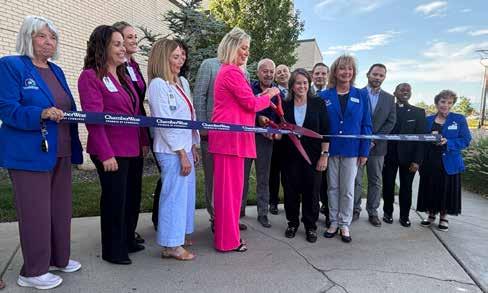
Holy Cross Hospital West Valley President Christine McSweeney, center in pink, and West Valley City Mayor Karen Lang cut the ribbon to mark the opening of a new chapel and remodeled lobby at the hospital. (Darrell Kirby/City Journals)
Bishop Oscar Solis of the Catholic Diocese of Salt Lake City leads a ceremony to commission and bless a new chapel at Holy Cross Hospital in West Valley City. (Darrell Kirby/City Journals)
Good4Life Markets bring the community ethos, pothos, produce
With evening farmers markets all summer long, backyard gardeners are encouraged to bring their oversupply too.
By Cassie Goff c.goff@mycityjournals.com
“Wegive visitors the opportunity to support local residents with the chance to connect right there with neighbors and other community members,” said Denise Christiansen.
Christiansen is the owner and market director of Good4Life Markets. The market managing company hosts community-oriented farmers markets where residents enjoy ripe produce and hand-crafted products – all while catching up with the neighbors.
“The local aspect is what’s most appealing – you are buying fresh flowers that have been grown in your neighbor's flowerpatch. It’s pretty cool that way,” Christiansen said.
Good4Life Markets began hosting neighborhood farmers markets in Herriman in 2021. In the four years since, they’ve been growing like some of their vegetables, opening farmers markets in Saratoga Springs, Taylorsville, West Valley, and Highland. Good4Life recently opened farmers markets in West Jordan on July 23 and will be opening markets in Riverton in August as well (held on Fridays at Riverton

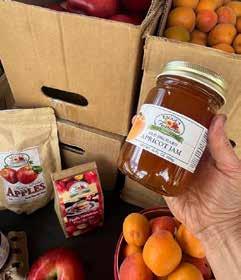
tiansen said.
She explained how backyard growers don’t have to go through special licensing to sell extra produce from their personal gardens or properties.
“If you have too many tomatoes, you can sell them to the public,” Christiansen explained.
“Maybe your apricot tree overproduced— bring them to market and we will have a table for you,” Christiansen said, adding that backyard growers can have a free table at Good4Life Markets.
Good4Life Markets typically follow the summer harvest schedule, following suit with their farmers and visitors.
So far this year, they’ve seen popularity with cherries, peas, summer squash, green beans, apricots, more cherries and cucumbers. In a few weeks, they anticipate a boom in corn and peaches.
Good4Life Markets not only have farmers and growers as vendors, but local bakers and crafters.
City Park).
When Christiansen began with Good4Life Markets, she knew she would have to work with her team to set themselves apart from other established farmers and markets in the valley.
“We’re newer. Those other markets have been in place for 25 years, so they get the big farmers on the weekends,” Christiansen said.

CITY COUNCIL AT-LARGE
• 45 years in the city and still raising my family here
• New blood = New Ideas
• A voice that listens
• I will always strive to do what is best for the city and its people
They knew there was a niche and opportunity for weeknight neighborhood markets.
Good4Life Markets hold all of their farmers markets in the evening (from 5 p.m. until 9 p.m.), which lends opportunity for more of the local farmers and backyard gardeners to participate.
“We are always looking for farmers and backyard growers in the state of Utah,” Chris-

Many bakers bring artisanal bread, cinnamon rolls and other baked goods. Other tables highlight meats, cheeses, hummus, dips and spreads, homemade jams and jellies and salsas. There has even been slushie and lemonade vendors.
“Grab a cup of strawberries with chocolate, that’s been really popular,” Christiansen said.
Other non-edible products include skin care products like goat milk soap and agricultural products.
“Our primary focus is to bring the sustainability factor,” Christiansen said.
Good4Life Markets aim to create community connection by working in various activities and entertainment to their farmers markets. So far, they’ve done open mic nights and bingo days.
“We have musicians of some sort weekly,” Christiansen said. “It may be a local university student, accordion player, strolling musician or buskers.”
A few food trucks have also been invited to a handful of the neighborhood Good4Life Markets.
“We try to not overdue it with the food trucks because they have their place,” Christiansen said.
Farmers markets will run through the end of September/beginning of October, depending on location. Good4Life Markets aim to make their vendors produce and products accessible so cash, card and even SNAP EBT benefits are accepted.
Christiansen and her team are looking to expand their kids program that began in West Valley to some of the other local community markets. They are looking for sponsors and volunteers to help with those programs.
To learn more about Good4Life Markets, visit their Instagram page or Facebook page by searching for: @good4lifemarkets.
Or visit their website at www.good4lifemarkets.com l
Even though it was over 100° F when Good4Life Markets first opened this summer, the evening markets allow the temperatures to cool down and the shade to provide cooler environments for the transfer of goods. (Photo courtesy of Denise Christiansen)
Good4Life Markets invites local farmers and backyard gardeners to sell at their local markets in varying cities in Salt Lake Valley. (Photo courtesy of Denise Christiansen)
Salt Lake County Public Defender appointed to fill council vacancy
Democrats pick public defender Jiro Johnson to fill county council seat vacated by Arlyn Bradshaw.
By Shaun Delliskave s.delliskave@mycityjournals.com
Salt Lake County’s governing body has a new member with deep roots in the community and firsthand experience with some of its most pressing social challenges. Remington “Jiro” Johnson, an assistant director at the Salt Lake Legal Defender Association until this month, was appointed to the Salt Lake County Council in mid-June to represent District 1. Johnson, who is 39, was chosen by the Salt Lake County Democratic Party to succeed Arlyn Bradshaw, who stepped down after 14 years to join the office of County Mayor Jenny Wilson. Under Utah law, when a partisan seat is vacated midterm, the political party of the departing member fills the vacancy.
The race to replace Bradshaw drew unusually high interest, with 17 Democrats filing to be considered. One candidate withdrew before voting, leaving 16 contenders, including nonprofit leaders, community organizers, and experienced political staffers. The party’s central committee used a ranked-choice voting system to whittle the field in multiple rounds. Johnson ultimately emerged as the winner after 13 rounds of balloting, receiving 53 votes to edge out his nearest rival by six votes. He
was formally sworn in days later during a brief ceremony at the County Council offices.
District 1 includes much of Salt Lake City, South Salt Lake, and parts of West Valley City. It covers neighborhoods that range from historic eastside areas to diverse westside communities like Glendale and Rose Park. The district is home to major commercial corridors, public transit lines, the Jordan River corridor, and much of the county’s urban homeless population. It has long been a Democratic stronghold in a county where political control is closely contested between Democrats and Republicans.
Johnson was born and raised in Salt Lake City’s Liberty Wells neighborhood. He attended West High School and earned a Bachelor of Science in Political Science with a minor in history from the University of Utah. While in college, he served as president of the Young Democrats of Utah and completed a Hinckley Institute internship at the Utah Legislature.
He went on to earn his Juris Doctor degree from George Washington University Law School in Washington, D.C., graduating with honors as both a George Washington and Thurgood Marshall Scholar. While in law school, he worked at the Federal Election Commission, focusing on campaign finance investigations, and contributed to the Federal Circuit Bar Journal.
After clerking and practicing in Washington, Johnson returned to Utah in 2013 and
joined Manning Curtis Bradshaw & Bednar, where he worked on complex civil and employment litigation cases. Two years later, he moved into public defense, joining the Salt Lake Legal Defender Association, where he rose to an assistant director role overseeing operations and training. The office handles thousands of cases each year for clients who cannot afford private attorneys, many of whom face challenges related to housing insecurity, substance use or mental health needs.
Beyond his day job, Johnson has served as president of the Utah Minority Bar Association and sat on the board of LGBTQ+ and Allied Lawyers of Utah. He has taught legal courses at the Utah State Prison and has mentored young attorneys entering the public sector.
Johnson has emphasized that he sees the County Council role as an extension of his work advocating for underrepresented and underserved communities. He has said he will focus on housing affordability, better support for unhoused residents, and treatment-based alternatives to incarceration for people with mental illness or substance use disorders.
His district includes some of the county’s highest concentrations of homelessness, with many residents struggling to secure stable housing. Salt Lake City and surrounding areas have experienced ongoing debates over the siting of shelters, affordable housing development, and the balance between enforcement
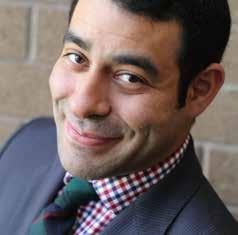
and social services.
He is the first Black and Japanese-American representative to serve in this role. He uses his Japanese middle name “Jiro” professionally, reflecting his mixed heritage and his commitment to greater representation of historically marginalized communities.
Johnson’s appointed term runs through January 2027, the end of Bradshaw’s original term. He has already indicated he plans to run in 2026 for a full four-year term representing District 1. l



Public defender Jiro Johnson was appointed to the county council. (Photo courtesy Salt Lake Legal Defender Association)

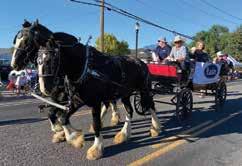




Larkin Mortuary’s dedication to the Utah community is deeply rooted in its history and family values. For over 140 years, spanning seven generations, the Larkin family has proudly served Utah families in their time of need. This commitment extends beyond providing funeral services; Larkin Mortuary actively engages with the community by hosting events and giving back through various service initiatives such as the annual Memorial Day Program, golf tournament, Trunk or Treat and Live Nativity.

Utah’s newest plant-based deli offers variety and convenience
The new plant-based restaurant, Vertical Deli, dishes up a plantbased diet, not a vegan lifestyle.
By Sienna Chubak s.chubak@thecityjournals.com
The Vertical Deli, a new branch of the Vertical Diner, recently opened in June on State Street and 3300 South. Ian Brandt, the founder and owner of the Vertical Deli, has been a part of the plant-based restaurant scene since 1998, but the deli operation is the start of something new.
“A diner has to be a very specific building, whereas a deli can be in a gas station. So it can be placed anywhere. So there’s not really a lot of limitations on that,” Brandt said.
Brandt has been working with general manager Taylor Duffus to create and expand their business. Duffus explained, “We sell a plant-based diet. We don’t sell a vegan lifestyle.” With an already limited audience, the pair is striving to keep their Vertical Deli doors open to more than just vegans.
Brandt is no stranger to catering to a smaller customer base. After studying hospitality at the University of Utah, he’s wellequipped to deal with the continual societal evolutions that his businesses have gone

through in the past 27 years.
In 2007, with the Diner’s original opening, Brandt began his own manufacturing for the business. He didn’t want to depend on other companies for things like quality control and consistent purchasing, so he got a warehouse and has relied only on his own business ever since.
“I always think there’s a way to make something work. You just have to figure it out. This is a business that should never have worked. Just doesn’t make sense, and it’s working,” Brandt said.
One thing that Brandt remains true to is never changing what he believes in just to bring in more business. “If half the menu were a vegan menu and half the menu was not, we would probably have 10 times the sales, because our food’s good. It just doesn’t speak for everyone’s demand,” Brandt said.
He is uninterested in trying to bring in more business by changing his menu to anything other than plant-based. “I guess that’s the benefit that you get from dining with us. You’re at least buying food from a company that truly believes in the mission behind what we’re doing and is not just trying to do it for the money,” Brandt said.
Their fully plant-based menu is already extensive, providing as many options, if not more, as any other restaurant would have. From breakfast and lunch to desserts and
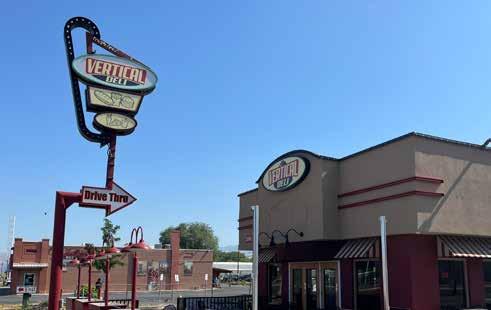
sides, and even a large number of gluten-free options, the Vertical Deli provides a plethora of delicious dishes for anyone to try.
Brandt isn’t interested in looking for a prime retail location, either, since he trusts his audience will find him. The Vertical Deli location isn’t somewhere with a lot of foot traffic like other ideal restaurant spots downtown; however, Duffus explained that they have a loyal customer base already from the





Vertical Diner, and the plant-based community is intimate; the people who want to eat plant-based will find them without a problem. Their new location is the first deli of many coming to Utah, and Brandt and Duffus both remain solid in their goal to keep their plant-based business as one that you can depend on to always honor what they believe in. l




The new Vertical Deli location serving a plant-based diet. (Sienna Chubak/City Journals)
Kai Pops bring cool tropical flavors to Utahns’ palates
Hawaiian-style treats embody the spirit of “Share the Aloha.”
By Collette Hayes c.hayes@mycityjournals.com
It
was while visiting his grandmother (ahma) in Maui, Hawaii, that 9-year-old Kekai Keala learned to make Hawaiian ice cakes. On those warm summer days, his ahma taught Keala the cherished homemade recipe. The ice cup treat was more than just a refreshing snack; it embodied the spirit of Aloha, making it truly special. It represented a lifestyle to share and a reminder to live with love, respect and compassion for everyone.
“When I came back to Utah from Hawaii, the summer I turned 9, I started selling Kai Pops at my brother’s football games,” Keala said. “I made them myself. I funneled the ingredients from Ahma’s recipe into Ziploc bags, sealed the bags, and froze them, making the perfect freezer pop ‘Aloha style.’”
A year after he started selling the freezer pops, COVID hit, and his family (‘ohana) became involved, going straight to online sales. His Kai Pop success story didn't stop there. Someone from Swig bought a Kai Pop, tasted it, and then called Keala to offer him a business deal.
“Swig wanted to sell my Kai Pops, and so, we hired a manufacturer and a co-packer to mass produce them,” Keala said. “I went from

making 100 Kai Pops here and there on my own to producing 250,000 at a time with a manufacturer. I sold with Swig for a year, and then my ‘ohana decided to invest in a food truck trailer instead of continuing with mass production. We have been selling online and out of the food truck ever since.”
Keala’s family now mass produces Kai Pops at a commercial kitchen in Springville, Utah. Every year, the company provides approximately 167 dozen freezer pops for the University of Utah Employee Appreciation Day. They also offer upper-number deliveries to special corporate events, weddings, birthday

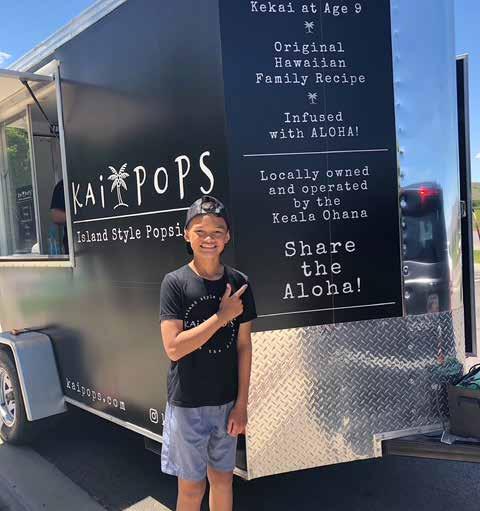
parties and golf courses.
“Kekai has two brothers, Kaluna, who is 18, and Kalama, who is 8. The three boys love working together, running the business. They are learning a lot of important life skills,” Kekai’s mom, Aisha, said. “I think one day Kekai and his older brother will take over the business and expand it. Kaluna just graduated from high school with an associate's degree. He’s going to the Marshall Islands to serve a mission for The Church of Jesus Christ of Latter-day Saints. When he returns, he plans to attend college and major in business. We always say Kekai is the creator, the founder, and the face of the company, and Kaluna is great with the business side.”
At this point, you may be curious to know what makes a Kai Pop a better choice than a regular freezer pop or even a Popsicle.
“A Kai Pop is unique because we have island flavors instead of the regular flavors usually available in Popsicles and Kai Pops are creamy and gluten free,” Keala said. “We make six flavors. Coconut and pineapple are my favorite because they are fruity, and I like those fruits in general. Malona tastes like honeydew melon and used to be my favorite, but my taste buds kinda changed. Lychee, some people say, tastes like a mix of a watermelon and a pear. It’s my mom’s favorite flavor. Additionally, we make Hawaiian Punch and mango flavors. Kai Pops are a once-in-a-
lifetime freezer treat. Once you try one, you’ll never go back to the other ones.”
Kai Pops are available for online purchase with in-store pickup. The food truck travels throughout Utah and is in Salt Lake once a week. Keala says, “Since I’m only 14, my dad drives the food truck, and whenever we have an event, we post on Instagram. You can also find us at golf tournaments, food truck roundups and carnivals. We usually have two or three events a week during the summer, and then it slows down during the winter.”
Keala plays soccer for the Utah Celtic soccer club out of Orem, and he still travels to Hawaii a couple of times a year. While there, he enjoys spending his days on Maui surfing the ocean's rolling waves until sunset.
“My ahma is now gone. When I travel to Hawaii, I stay with my uncles and aunts,”
Keala said. “Kai Pops carries on ahma’s legacy of always remembering to 'Share the Aloha.’”
When asked what the secret ingredient is that makes the freezer pops so delicious, “It’s the Aloha,” Keala says with a huge smile. “My ahma taught me that, and it comes in every Kai Pop!”
To order Kai Pops on-line visit www.kaipops.com/.
For Kai Pops food truck schedule, visit Instagram @ Kai_Pops l
From left to right: Ahma (grandma) with Kaluna, Kalama and Kekai Keala. (Photo courtesy Aisha Keala)
“When I came back to Utah from Hawaii the summer, I turned 9, I started selling Kai Pops at my brother’s football games,” Kekai Keala said. “I made them myself.” (Photo courtesy Aisha Keala)
Wasatch Community Gardens expands its urban farming initiative with help from Tito’s Vodka team members
Community volunteers were aided by Tito’s Handmade Vodka team members as they helped to complete various tasks at Wasatch Community Gardens’ new city farm.
By Lizzie Walje l.walje@mycityjournals.com
Wasatch Community Gardens is advancing its urban farming initiative with help from an unlikely collaborator, Tito’s Handmade Vodka based in Austin, Texas. For four years now, the spirits brand team members have assisted in the garden, helping to enhance its ability to deliver fresh produce to those in the community who are in need.
Wasatch Community Garden is one of many places that Tito’s has assisted over the years, thanks to its Block-to-Block program. The program has blossomed into a nationwide success, but like most programs, it started small. Per Tito’s website:
“The idea started in our own backyard: make fresh food accessible for Tito’s team members. We built the Fourteen Acres Farm (in Texas) to do just that, creating an environment where fresh produce is easily
accessible. From a no cost farmers market, to lunch cooked onsite using fresh produce from the farm, inspiration to eat well is everywhere you turn.”
Following the success of Fourteen Acres Farm, Tito’s decided to expand their efforts, creating Tito’s Block-to-Block, a program that seeks to help communities expand their ability to provide fresh produce to various communities. Tito’s has since partnered with various community gardens and nonprofits across the country, helping to bring education and resources to farmers, gardeners and community members alike.
This past June, Tito’s and Wasatch Community Garden came together once more, for a service day where volunteers worked alongside one another. This year one of the main goals was to build infrastructure designed to expand the garden’s food production capabilities. This included constructing a paved outdoor kitchen area, tending seedlings in the greenhouse, and preparing various garden beds for planting. These projects were all designed to help the farm reach its ultimate goal of becoming fully operational.
During their four years of partnership, Tito’s and the garden have accomplished a lot, including launching two new community gardens, building a greenhouse and revital-
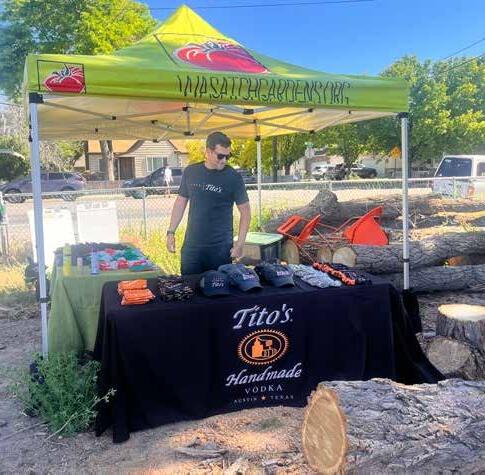
izing the Green Phoenix Farm in 2022. The following year in 2023, they began the initial transition to the new City Farm site. This was done by preparing the necessary materials and plants for transport. In 2024, they continued to carry out the second phase of the project by laying the structural groundwork for the ongoing relocation.
“This farm was built with plenty of people power. Whether it’s volunteers, donors, community partners,” said Katie Dwyer, the executive director of the garden. “They’ve helped us in our community garden spaces. They’ve also come to our old farm location to help build a greenhouse. They helped us move that location across town to this new site last year, and they’ll be helping us build a paved, outdoor kitchen.”
The kitchen will help the garden tremendously, serving as a space for volunteers to teach classes, such as how people can learn how to prepare and preserve the food they grow in their home gardens. The classes are yet another way that the garden hopes they can bring in more members of the community and make them aware of all the space has to offer.
This year’s day of service saw volunteers helping to transform a food preparation area, build a 900-square-foot patio, prep gar-
den beds and complete various tasks around the farm.
Per the event’s media release, “Food grown at the City Farm will be incorporated into daily meals for Wasatch Community Gardens program participants and distributed to community service organizations that provide meals and fresh produce to 1,000 low-income individuals and families in the area. The updated farm will also help Wasatch Community Gardens continue to serve the surrounding community. Annually, their programs and events serve over 13,000 people (about 50% coming from low- and moderate-income households) with the help of their dedicated volunteers. Last year, in 2024, 2,365 volunteers contributed 8,917 hours in support of the nonprofit and community members served.”
With another day of service in the rearview mirror, Wasatch Community Garden looks forward to more collaborations with Tito’s in the future, as they work toward securing City Farm as a pillar of food assistance in the community.
As Dwyer said, “Gardens and the sharing of food are what build community connections.”l
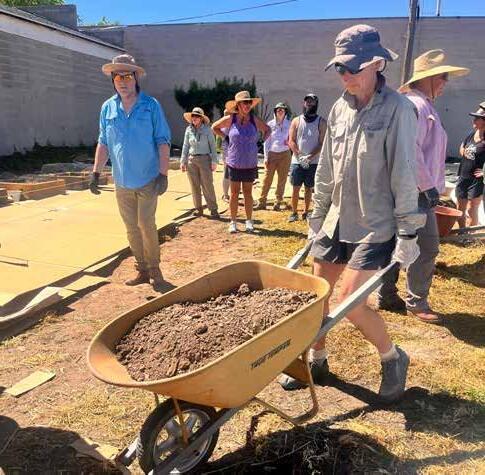
This year marks the fourth in which Tito’s has helped Wasatch Community Gardens as part of its Blockto-Block program. (Tito’s)
With help from Tito’s, community volunteers helped with numerous projects from building new plant beds to laying pavement for an on-site kitchen. (Tito’s)
Bridging the gap: Making farm-to-fork products affordable
Misconceptions about the cost of locally-produced food keep some families from enjoying the benefits.
By Peri Kinder peri.k@thecityjournals.com
Local farmers markets are welcome events, recognized for delivering fresh, seasonal produce and food items. But for some families, the price of farm-fresh products seems to be too high, creating a nutritional divide for lower-income households.
Natalie Loots wants to change that narrative. She is the Community Food Security Program manager with the Utah Department of Health and Human Services and said there are several programs available to make farmers markets accessible and affordable.
“Our main goal is to make local foods, like fruits and vegetables and other high-nutrition foods more affordable for low-income folks,” Loots said. “Our main program that we operate is called the Double Up Food Bucks program, which has been around since 2015.”
With Double Up Food Bucks, people enrolled in the SNAP program can get up to $20 of free Utah-grown produce with every visit to a participating market. The program offers a dollar-for-dollar match, up to $20, matching SNAP benefits.
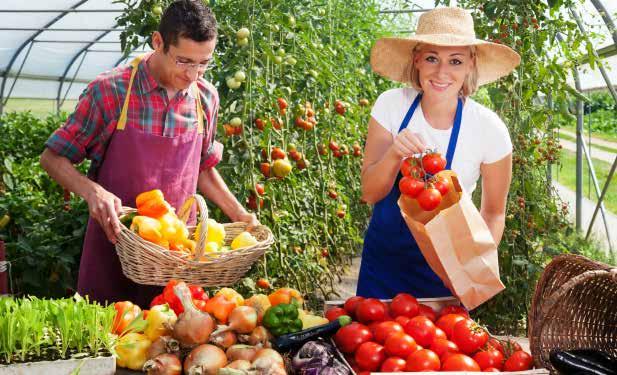
“If folks go to the information booth at the farmers market, they swipe their SNAP card and they’ll get tokens for SNAP and then tokens for Double Up to use at the different vendors at the market. There’s no paperwork they need to fill out. All they have to do is have a valid SNAP card that is currently active.”
Loots said the CFSP works to eliminate barriers that limit access to nutrition-
ally-dense foods. Initiatives like the Senior Farmers Market Nutrition Program offers low-income seniors a $50 farmers market voucher to use throughout the season. Utah Produce Rx partners with local healthcare clinics to create a $300 fruit and vegetable prescription patients can use at participating farmers markets.
Caroline Hargraves serves as the marketing director for the Utah Department of
Agriculture and Food’s economic development division. She said while prices might be higher on some items at farmers markets, the food quality and nutritional value is much better than what can be found in many grocery stores.
“I think a lot of people don’t understand that it takes time, energy and labor to produce food. We have such a culture in America of expecting food to be cheap but people who produce it deserve a living wage,” Hargraves said. “Farmers get such a small portion of the dollar that the average consumer pays at the grocery store and I think people don’t understand that. But when you buy directly from farmers at a farmers market, that money is going directly to them.”
Utah’s DHHS operates a local food purchasing assistance program to help socially disadvantaged farm owners. Since the spring of 2022, the program has purchased food from local farmers to distribute to families experiencing food insecurity.
More than 60,000 individuals have received farm fresh food at nearly 600 distribution events across the state. This will be the last summer the program will be utilized, as federal funding has been cut, but organizers are looking for additional funding sources.






















A 2025 Utah State University study, Cultivating Community and Commerce: A Summary of the Statewide Social and Economic Impacts of Utah Farmers Markets, found that farmers markets offer more than just fresh produce. Communities hosting farmers markets fostered community connection, empowered small businesses and contributed to the state’s economy.
The study also found food deserts are prevalent in the state. These areas have limited access to nutritious food, affecting more than 800,000 Utah residents. Farmers markets address this dire need, so affordability is key.
“We have several initiatives at the Department of Agriculture and Food to encourage people to support local farmers and ranchers,” Hargraves said. “It does make a difference, both for that individual, like a farmer or business owner, and for the community. The more dollars we can keep circulating in our local economy, the better. But also it tastes better. With local foods, you can taste the difference.”


For more information about farmers markets affordability programs, or to find participating markets, visit uah.org/ get-help.
“Our work is aiming to make food security accessible in a way that it functions as a social determinant of health,” Loots said. “Farmers markets are for everybody, and we try to make eating local produce accessible to everybody…Access to healthy foods affects chronic disease outcomes or health outcomes, longevity and quality of life. Those are so deeply connected.” l
Locally produced food has better health benefits and can be more affordable than people realize. (Canva stock)
When the cafeteria closes: The harsh reality of summer hunger for kids
Summer is the most difficult time of year for students who rely on school lunches and breakfasts.
By Lizzie Walje l.walje@mycityjournals.com
The Utah Food Bank has historically dubbed summer as the official season of hunger. To some, this might come as a surprise. However, when schools shut down for the summer, so do breakfast and lunch programs, which students often rely on to ensure they’re receiving meals throughout the day.
According to Feeding America, the country’s largest nonprofit organization dedicated to combatting hunger, one in five children in the United States are currently facing food insecurity. In Utah specifically, the ratio is one out of eight people for adults, and one out of six for children. In Utah alone, roughly 220,000 kids rely on school lunch and breakfast programs for their daily nutrition.
The effects of hunger have long been studied and documented, showcasing that regardless of age, missing even one meal can result in a slew of negative consequenc es, both chronic and acute. Feeding America explains why food insecurity is particularly dangerous for our youngest residents:
“For children, food insecurity is particu larly devastating. Not having enough healthy food can have serious implications for a child’s physical and mental health, academic achievement and future economic prosperi ty. Research shows an association between food insecurity and delayed development in young children; risk of chronic illnesses like asthma and anemia; and behavioral problems like eating disorders, hyperactivity, anxiety and aggression in school-age children.”
Who you are can also have bearing on your potential to face food insecurity. While food insecurity is an issue that effects people of all backgrounds and circumstances, Black and Latino children are twice as likely to face hunger compared to their white coun terparts. Another common risk factor for childhood food insecurity is growing up in a single parent household. In 2022, children who lived in a single income household, typ ically led by single mothers, were 33% more likely to experience hunger.
Historically speaking, summer is al ways a difficult season for reconciling hunger. However, 2025 has presented new challenges, especially following budget cuts implemented by the U.S. Department of Agriculture. Back in March of this year, two federal programs were cut, resulting in a combined loss of nearly $1 billion in funding for schools and food banks to buy directly from local farms, ranchers and producers. At the time, the agency claimed it was a deci sion that would help “return [the agency] to long-term, fiscally responsible initiatives.”
The decision was made by the Trump Administration and Elon Musk’s Depart
ment of Government Efficiency or DOGE. At the time, they claimed the decision to cut funding was a means to slash federal spending, and therefore, reduce government waste. Previously, the USDA programs in question were funded through the agency's Commodity Credit Corporation, a Depression-era fund created to buy products directly from farmers. The cuts resulted in a loss of about $660 million in funding this year for the Local Food for Schools program, which is active in 40 U.S. states, including Utah.
Despite the jarring budget cuts, the Utah Food Bank sprang into action, as they are accustomed to doing ahead of the summer months. Back in March, they held an event called Feed Utah which was lauded for its convenience. Ahead of the event, pamphlets were left on residents’ front doors which explained how they could participate by either gifting a financial donation or leaving a bag of nonperishable food on their door-

anyone under 18 will receive a meal, or they can access a closed enrolled site if they’re participating in specific activities.
Each site will offer either individual daily meals or a weekly box containing seven breakfasts and seven lunches. Meal types and schedules vary by location, but all sites will be closed June 16, July 4 and July 24 in observation of state and federal holidays.
your neighbors.”
After the success of the Feed Utah event, it was time again for the food bank to start tackling its most critical season: summer. Preparations for summer often begin as early as Thanksgiving and Christmas of the prior year, and with the added stress of federal budget cuts looming, it was imperative to get a handful of programs and events on
To find a meal site near you, visit www.UtahFoodBank.org/SummerMeals, text “SUMMER” to 914-342-7744, or call the USDA National Hunger Hotline at 1-866-3-HUNGRY. More than 300 sites are available statewide, with Utah Food Bank operating 60 of them. Children must be present to receive a meal.
Another helpful program children can utilize this summer is SUN bucks or summer EBT. Eligible families will receive a $120 credit for each school-aged child in the household. To learn all about the SUN bucks



Photo: Don Polo Photography
Working in the food industry? Look to see if this certification is needed.
By Julie Slama j.slama@mycityjournals.com
Whetheraspiring of becoming a sous chef, planning to serve street tacos from a food truck or seeking a part-time restaurant job — one thing is almost always required first: a food handlers permit.
Many states, including Utah, require food service workers to complete food safety training before receiving their permit. This applies to those who prepare, serve or handle food for public consumption from restaurant staff and caterers to food truck operators and others whose roles involve direct contact with food.
Before handling food, handle this

Obtaining a food handlers permit may be a good idea to work in the food industry profession in Utah. (Photo courtesy of Salt Lake County Health Department)
of the things taught in the training classes, like handwashing hygiene, cross contamination in food, temperature control — holding at the

will receive a temporary permit; the official Utah Food Handlers Permit will be mailed within 30 days. The permit is valid for three years. The course must be retaken for renewal.
Since 2013 the Utah Department of Health has approved third-party agencies to conduct the training, although local health departments can provide training as well and they are responsible for issuing the permits. From July 1, 2023 to June 30, 2024, Salt Lake County Health Department issued 41,240 of the state’s 109,865 food handlers permits.
To find a certified provider, visit the state’s approved training list: www.epi.utah. gov/wp-content/uploads/foodHandler_list.pdf. Providers may offer in-person or online options, sometimes in multiple languages. Check to ensure the online courses are compatible with all devices and operating systems.
The base cost of the training is $15, though agencies may include additional processing or administrative fees. In some cases, employers may cover the cost or offer group discounts.
Additional licenses, permits or certifications may be required for specific roles — such as serving alcohol, being a food manager, running a food truck or operating a booth at a farmers market.
“Different agencies will have requirements,” Oaks said. “In Salt Lake County, all restaurant workers have a food handlers permit, but for example, there are companies that package produce locally, like a bag of carrots or lettuce, and they are regulated by the state’s agriculture and food department. But within their facilities, they require food handlers permits or some other certification. Some companies may say, we still want you

to get a food handlers permit. We have almost 5,500 restaurants (and others that serve food) so all their employees either have managers’ certificates or food handlers permits. Usually, the grocery store employees have food handlers permits if they're working in the deli or the butcher shop or the produce, where they're cutting and doing food preparation and established concessioners such as the (University of Utah) Utes or Utah Jazz have food handlers permits.”
“It’s best to check with your local health department to get specific conditions and information on the type of food service that is being provided so they can help people learn what is required,” Fairclough said.
She said the food handlers training and certification program is regularly reviewed by state officials, local health departments and industry professionals to ensure it aligns with the latest (2022) version of the FDA Food Code, along with Utah-specific amendments. The Food Code is designed to protect public health and provide a standardized approach to food safety across various service environments.
Oaks, who has taught food handlers permit classes, said he had parents who would bring their kids to get a food handlers permit.
“It’s good knowledge and they wanted their kids to know; it had nothing to do with employment,” he said. “If you want to up your game for food safety, food preparation or food serving at home or wherever you might be, it's not a bad idea to get it. Not all states require a food handlers permit, but I’m glad Utah does. I'm glad our legislature and our state health department see the value in it, so there's at least a minimum standard for food workers.” l
Survey seeks questions readers have for their local government candidates




Fill out our survey so your candidates know what questions to answer for our Voter Guide.
Welcome to the City Journals survey! We're happy to have you here and for the opportunity to learn about how our newspapers are being utilized in our communities.
In the October issues of our newspapers, we will publish a Voters' Guide to provide readers with information about the candidates listed on each municipal ballot.
each candidate. Take a moment to consider what information ultimately makes or breaks your decision to vote for a specific individual in our local elections.
“It’s important to have candidates answer the actual questions their constituents would ask them,” said City Journals Creative Director Bryan Scott. “This is your chance to do that.”

We understand how voters can visit many different resources and websites and end up looking at the same information—if not the exact same wording or candidate platforms. We hope to provide readers with the information they want to know about
Scan this QR code to fill out the short survey.
Please respond to the survey found through the QR code, which will take less than three minutes to complete. Your response will help guide the design of our Voters’ Guide.
The “submit” button must be clicked before Monday, Aug. 18 (at 11:59 p.m.).
Thank you for your continued readership and support of your local staff here at the City Journals.
Summer heat forces West Valley Library to close at 2 p.m.
West Valley library will close early for the next few weeks due to excessive summer heat.
Due to problems with the building’s air conditioning system, the West Valley Library at 2880 W. 3650 South will be closed during afternoon and evening hours for the next several weeks. The library will be open Monday through Saturday from 10 a.m. to
2 p.m., but closed after that until the system can be repaired or replaced.
A spokesperson at the library said there is no definite date for regular hours to resume. It will depend on daytime temperature forecasts and when the branch is able to maintain comfortable temperatures in the afternoons and evenings. Library updates will be posted online at www.citylibrary.com/ public-libraries/west-valley-library. l
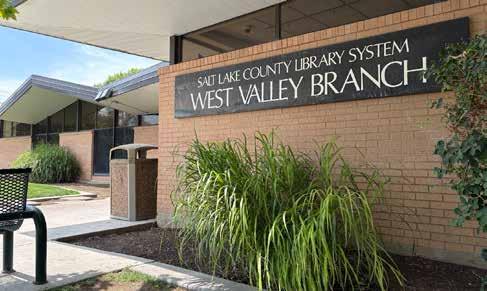
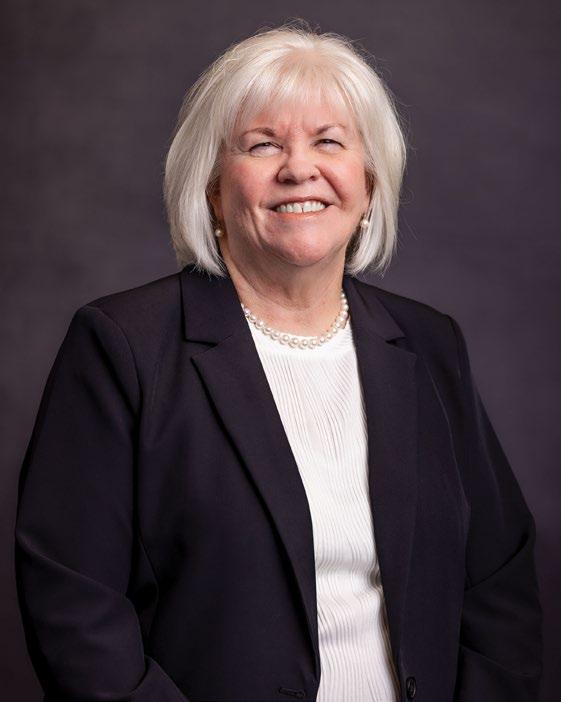





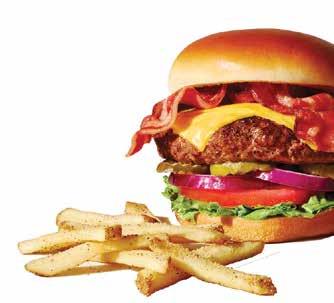




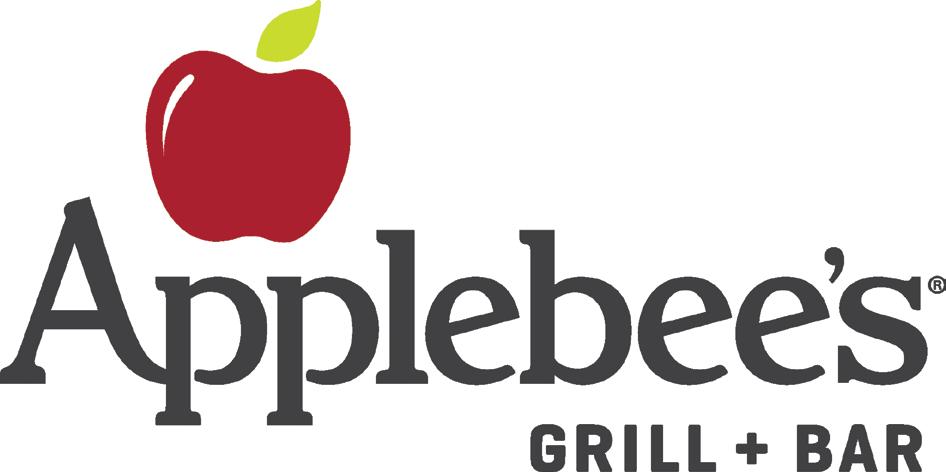


















Tips and tricks for lunch remix
Help for parents looking for healthy and fun school lunch ideas.
By Jet Burnham j.burnham@mycityjournals.com
foods, sugar and synthetic food dyes are the latest antitheses of healthy childhood nutrition. The USDA has called for changes to school breakfast and lunch menus that limit sugars and utilize locally sourced products. And the Utah Legislature just passed a bill to ban synthetic dyes and certain additives in foods served in Utah schools.
“There's definitely a big trend moving towards the more natural side of things, or trying to move away from that processed food and the artificial dyes,” Sharon Turner, a certified nutritionist, said.
Healthy food not only fuels kids’ physical development but it also boosts their ability to learn, said Turner, who works at the Utah State Board of Education.
“Students need to show up nourished and healthy to learn and perform their best, so it's important that they're getting a good breakfast and a good lunch, and they're able to pay attention in class and socialize and get the full benefit of their educational experience,” she said.
Keeping track of what kids should and shouldn’t be eating can leave parents feeling overwhelmed and unsure about what to pack in school lunches. Turner suggests three tips
to ensure kids have healthy, appealing and safe food to fuel their learning as they head back to school.
1. Pack a variety. Kids should eat an assortment of foods from wholesome food groups—fruits for fiber, carbs and natural sugars, and vegetables for nutrients such as iron, beta carotene and antioxidants. Whole grains and proteins complete the meal.
Try this: Charcuterie boards are a healthier reinterpretation of the Kraft Heinz Lunchables, which have always been popular with kids. Create your own by mixing and matching different ingredients from a variety of food groups and arranging them in a compartment-style container. Punch up the appeal with whimsical shapes created by cookie cutters or food molds.
2. Pack protein. “The best thing to do would be to pack something protein rich to keep the student satiated throughout the day,” Turner said. Options include hard boiled eggs, nuts, seeds, jerky, cheese, chicken salad, hummus, beans, peanut butter or protein pancakes, quinoa granola bars, edamame and overnight oats.
Try this: A protein-packed, crunchy alternative to potato chips is easy-to-make roasted chickpeas. Rinse and drain a 15.5 oz can of chickpeas/garbanzo beans. Let dry on a paper towel for 15 minutes. Toss with 1 tablespoon of olive oil, 1 teaspoon garlic salt and ½ cup finely grated parmesan cheese. Spread seasoned chickpeas on a baking sheet and bake for 25-30
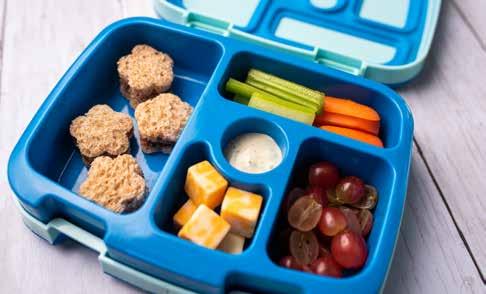
minutes at 400 degrees or until crunchy. Recipe by Pretty Providence.
3. Pack ice. Send foods containing mayo, meat, dairy or eggs in insulated bags with an ice pack. “Not only are you making good choices, but the food is stored properly and safely as well, and it's not going to heat up and make the child sick,” Turner said. If that’s not an option, stick to foods that are shelf stable and appealing at room temperature such as crackers, muffins, freeze dried fruits and vegetables, trail mix or unpeeled whole apples or bananas.
Try this: Laura Fuentes of the website
MOMables suggests ice packs should be placed directly by the foods that need to remain cold. However, ice packs can add to the weight of an already heavy backpack and can also sometimes go missing. Her solution is to substitute ice packs with frozen food items that will keep foods cold but eventually thaw to become part of the menu. Foods you can freeze as an alternative for an ice pack include a juice box, bottled water, yogurt tube, applesauce pouch, banana (peeled), berries, grapes, pineapple or mango chunks, mini muffins and cheese sticks. l












Containers with compartments creates a colorful charcuterie-style lunch. (Adobe stock photo)
Community Hero: Max Elliott Celebrates 65 years of dedicated service to Davis County
By Becky Ginos becky.g@thecityjournals.com
been 65 years since Max Elliott started his career in the Davis County Surveyor’s Office and he’s still going strong. Elliott was just reelected as Davis County Surveyor for another three years – so retirement is in the distance.
“Surveying is kind of a unique line of work,” said Elliott. “You’re more outside than inside.”
It was more or less luck that brought him into the field, he said. “I worked under Don Davis then worked under Glenn Austin. When he retired I served the remainder of his term.”
Elliott served as the elected surveyor for eight terms and in 2021 started his ninth term. During that time he had only one challenger for his position.
“If there was an election and they found out he was running nobody was willing to run against him,” said Administrative Secretary Louise Miller. “Everybody respects him. He knows everything about Davis County. If you ask a question he’ll know where to find the material.”
Max is wonderful to work for, she said. “He lets us do our job but he’s there if needed. I’ll be working on something and he'll ask if I need to sit down or suggest I need time off. He cares about us.”
He treats everyone with respect and kind-
ness, Miller said. “If the public comes in and needs something he’ll give the answer but if he doesn’t know the answer he’ll search until he finds it.”
“I have known and worked with Max for many years,” said Chief Deputy Surveyor, Kyle M. Corbridge. “One day we were surveying in an open field and we were using a 300 foot metal chain to measure distances with. Max took the front end of this metal tape and I held onto the rear end of the chain.”
Corbridge said Max went out about 295 feet from him to set a point in the ground. “I was standing next to an electrical fence the farmer had to keep his livestock in. I was holding onto the reel of this tape secured onto a wooden handle. I somehow ‘accidentally’ made contact with this fence and about 300 feet away I heard a commotion. It took some time before he was able to laugh about that.”
“I’ve seen a lot of changes in 65 years,” said Elliott. “I used to work with steel tapes that were 300 feet long. Now we’ve got global system positioning. It can tell within a dime in an area if it’s done right.”
There’s satisfaction in keeping the real map (which is the earth itself) in place, said Elliott. “It’s quite a job keeping those points in place with all of the growth.”
Elliott said surveyors are concerned that in a few years there won’t be enough people interested in the field to follow in their footsteps.
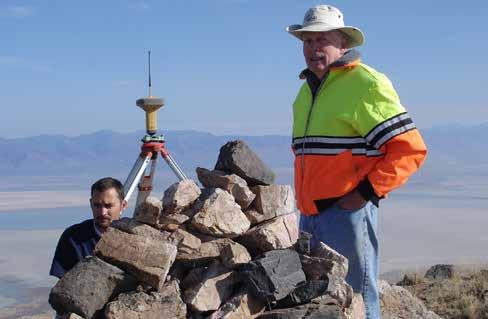
“Most surveyors are in their 50s, 60s or 70s. I know if they got involved in doing it they’d be excited to come into the profession. I don’t think you can meet anyone who would say they don’t enjoy it.”
“I know him as a man of integrity,” said Corbridge. “As a surveyor he is thorough, en-
suring the work is being done in an accurate and precise manner. He has been a great leader, teacher and mentor through his examples and patience.”
“I thoroughly enjoy this profession,” said Elliott. “I got into it and stayed.” l



Max Elliott stands on Frary Peak. Elliott has three more years in his term as Davis County Surveyor (Courtesy photo)

















County? City? What’s the difference?
Have you ever wondered what Salt Lake County actually does? If you live in one of the 23 cities in our area—like Murray, West Valley, South Jordan or Millcreek—you might think the county doesn’t affect your daily life. But the truth is, Salt Lake County helps all of us in big and important ways. Everyone who lives in the Salt Lake Valley is part of Salt Lake County.
Salt Lake County is like the glue that holds many parts of our community together. While cities take care of things like neighborhood parks and snow plowing on local streets, the county provides services that work best when shared by everyone. These regional services save money and help us all live better.
What Services Does Salt Lake County Provide?
Let’s break it down. Salt Lake County helps in areas like:
- Public Safety and Criminal Justice: The county runs the jail, provides prosecutors and public defenders, and helps with emergency response. In fact, public safety is the county’s biggest responsibility—it makes up over 74% of the county’s general fund.
- Elections: The county clerk makes
Aimee Winder Newton

sure elections are fair and secure. Cities contract with the county clerk for their municipal elections.
- Health Department: The county helps keep our community healthy by inspecting restaurants, giving vaccines, and cleaning up unsafe places like abandoned camps.
- Senior Services: Through programs like Meals on Wheels and senior centers, the county helps older adults stay active and connected.
- Mental Health and Addiction: The county leads programs for people who need support with mental illness or substance abuse, partnering with other groups to reach more people.
- Libraries: The Salt Lake County Library system serves most of the area (Mur-


ray and Salt Lake City have their own), giving people access to books, computers and classes.
- Parks and Recreation: From big parks and trails to swimming pools and rec centers, the county helps families stay active both indoors and outdoors.
- Arts and Tourism: The county owns facilities like Abravanel Hall and the Capitol Theatre, and brings in out-of-state visitors through conventions and tourism, which boosts our economy. The county owns the Salt Palace and Mountain America Expo Center.
- Property Tax and Land Records: The county collects property taxes (even for cities and schools) and keeps track of land ownership and real estate records.
A Government That’s Smart With Your Money
Salt Lake County has a budget of about $2 billion. While that sounds like a lot, only part of it is under the County Council’s full control. About $500 million of the total budget is what we call “passthrough” taxes—meaning the county collects it and passes it to others, like UTA or cities.
To stay financially strong, the Salt Lake County Council keeps a close eye on
spending. They’ve helped the county keep a AAA bond rating—the highest possible score, showing the county is careful with its money. The council also does stress tests and checks each department regularly to look for savings and to improve services.
Utah law doesn’t let counties collect more money just because home values rise. Instead, counties can only collect more if there’s new growth, like a new building. That keeps taxes fair, but it also means the council has to plan ahead and budget wisely.
One County. Many Communities. One Mission.
Salt Lake County doesn’t replace cities—it supports them. Whether your city needs help with road signs, snow removal or mapping, the county can step in with expertise and resources. It’s about teamwork.
The county’s job is to serve, support and strengthen every community in the region. By managing big services, using your tax dollars wisely, and working across city borders, Salt Lake County makes life better for all of us.
So next time you vote, enjoy a park, visit the library, or call for help—remember, Salt Lake County is there for you. l






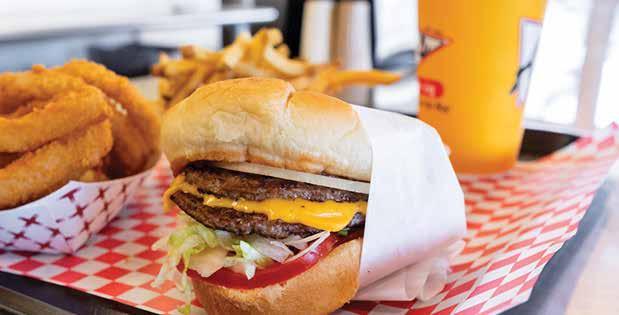
























There was no “gentle parenting” in the ’70s, especially at the dinner table. You either ate what was prepared for you, or you were labeled a sniveling, spoiled brat who didn’t care if children in China starved because you wouldn’t eat your meatloaf.
One time, I was forced to stay at the table until I’d eaten all my potatoes. I blame my dad. He had told me that potatoes have eyes and then lost his mind when I refused to eat mashed potatoes. I was convinced the lumps were eyeballs and I was not about to eat potato eyeballs.
I wasn’t trying to be picky, I just didn’t like things that were mushy, smelly, runny, squishy, eggy or slathered in mayo.
Grandma Stewart considered me the most coddled child in history. She could not fathom how I could reject her slimy bowl of lima beans, which included (if memory serves) onions, ham, shampoo and arsenic.
“If you don’t eat your lima beans, it just means you're spoiled,” she huffed when I put my head on the table to cry. She said the same thing when I refused to eat bread crust, cottage cheese, tuna fish or canned beets.
Side note: Grandma loved Jordan almonds, the only food she refused to share. She’d hide them from the grandkids because she knew we’d eat them. We scoured the cabinets until we found them and devoured every last one. I think that’s called a self-ful-
West Valley
Foods that ruined my childhood
Peri Kinder Life and Laughter

filling prophecy, Grandma.
As a kid, terrible food was everywhere. If I wasn’t being subjected to a disgusting recipe Mom found in a McCall’s magazine, I was being betrayed by school lunch ladies. They’d slide a quivering square of delicious cherry Jell-O, topped with whipped cream, onto my lunch tray. But the joke was on me when I took a big bite of the tasty dessert only to learn it was sour cream, not whipped cream. Who does that to a child? Sadists, that’s who!
While eating dinner at a friend’s house, her mom shamed me for not eating the disgusting canned peas. So, I ate it and cried. It was just another meal I was forced to eat, like a hostage.
Sometimes, I’d take a proactive approach when it came to avoiding foods I didn’t like. Mom often made chicken pockets, which were shredded chicken mixed with cream cheese, baked into crescent roll dough. I hated cream cheese (mushy,

smelly). When I saw it in the fridge, I cried. I hid the box of cream cheese behind the wilted lettuce in the vegetable bin, but Mom always found it.
Other ploys included acting sick (rarely worked), “forgetting” about dinner while playing outside (never worked), pretending to sleep on the couch (sometimes worked) and throwing a fit at the dinner table (never worked, plus I lost dessert).
I don’t know why Mom refused to accommodate my delicate palate. I was only repulsed when it came to sauces, dressings, mustard, canned foods, Vienna sausages, tuna, cottage cheese, sour cream, maple syr-
up, vegetables, macaroni salad, yogurt, the textured vegetable protein popular in the ’70s or anything slathered in mayo.
It didn’t matter. I was expected to “Learn to like it, or else!” Or else, what? A grateful digestive system? A lack of nightmares? A healthy relationship to food?
With four daughters, I understand how hard it is to make meals for ungrateful children. I’ve had daughters who refused to eat pizza, spaghetti, meat, dairy products, lasagna, hamburger casserole or anything with onions. They probably have their own list of foods that ruined their childhood. That’s what therapists are for. l




































